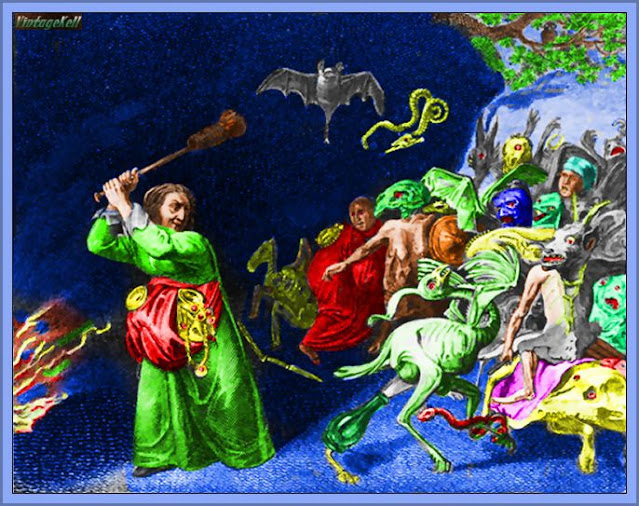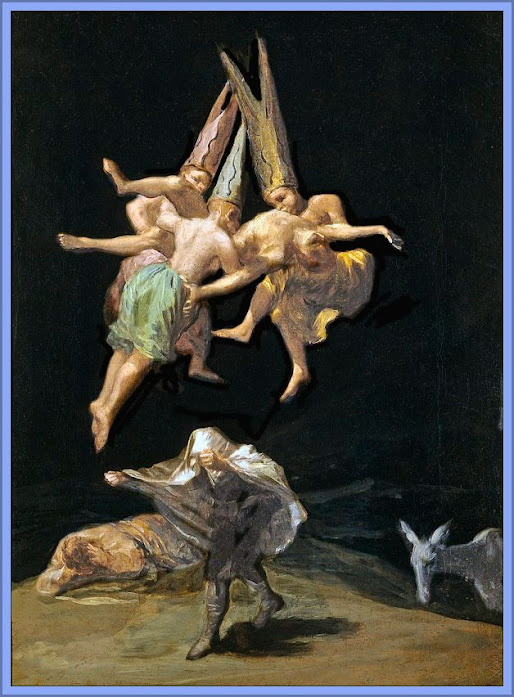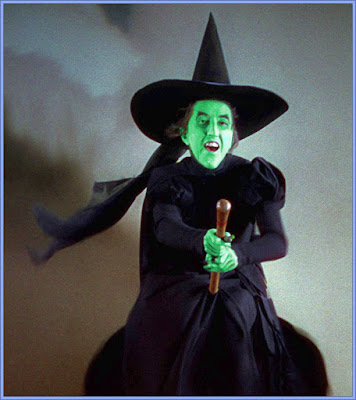 |
| Wizard With Pointy Hat |
....... everyone knows that don't they?
But what makes us so sure?
 |
| A Witch By Kyckaert (1650) (Colourised). .... No Pointy Hats. |
After all many woodcuts from the Middle-Ages show witches wearing a variety of different hats, such as head-scarves, and even depict witches as not even having any head-wear at all and instead showing their hair being uncovered or windblown (if flying) ...
 |
| Witches' Flight - Goya (1798) ..... Male Witches With Pointy Hats As Horns. |
One possibility is that it might have been an exaggeration of the cap known as the 'dunces cap', or the edgeless hats the Puritans and the Welsh wore, and which the Christian Church disliked, associating the points to those of the devil's horns. The witch hat is a more brimmed version of the cone-shaped hats commonly worn by male-gendered wizards and magicians. During the Victorian age, fairy tales began depicting black-coloured conical hats and crones as symbols of wickedness in their illustrations, and this carried on into cinema such as Disney's Snow White or MGM's The Wizard of Oz.
 |
| Cinema Sealed The Image Of The Pointy Hats .... |
Another possibility is that its a throwback to the time of the Etruscans and the Romans, as the both worshipped a goddess named Diana who had become commonly associated with witches in the middle ages. Coins from the Etruscan city of Luna depict her as wearing a brimless, cone-shaped hat.
But I think it goes far deeper in time than that .... the Bronze age saw the emergence of shamans and priests who wore golden pointy hats. Decorated with astrological symbols that would allow the wearer to predict phases of the moon and other astrological events that would have made them powerful mages to their peoples.
 |
| Golden Pointy Hats ,,,, |
The golden cones were attached externally to long conical and brimmed headdresses which were probably made of some organic material and the four Golden Hats known as of 2012 are:
- The Golden Hat of Schifferstadt, found in 1835, circa. 1400–1300 BC.
- The Avanton Gold Cone, incomplete, found in 1844, circa. 1000–900 BC.
- The Golden Cone of Ezelsdorf-Buch, found in 1953, circa. 1000–900 BC; the tallest known specimen at c. 90 cm.
- The Berlin Gold Hat, found probably in Swabia or Switzerland, circa. 1000–800 BC.
They may well have been ceremonially buried with the death of the wearers, and certainly there were more than just four of them made. I think a folk memory of these powerful magicians from pre-history carried on through the ages, and re-emerged when wizards, warlocks, and witches became safe to talk about again.

That's a good question - where does the Witch's hat come from? Part of the answer must lie in the extra height afforded by such a headpiece. Any important or powerful figure would have had garments which confirmed or exaggerated their larger-than-life status.
ReplyDeleteI accept that wearing tall pointy hats may evince power, but they also have a long history as just an everyday headgear with no power connotations.
DeleteAs I suggested in the post, the connection and association with magic is possibly way back, to a time in our folk memories when shamans wore such items e.g. Golden Pointy Hats